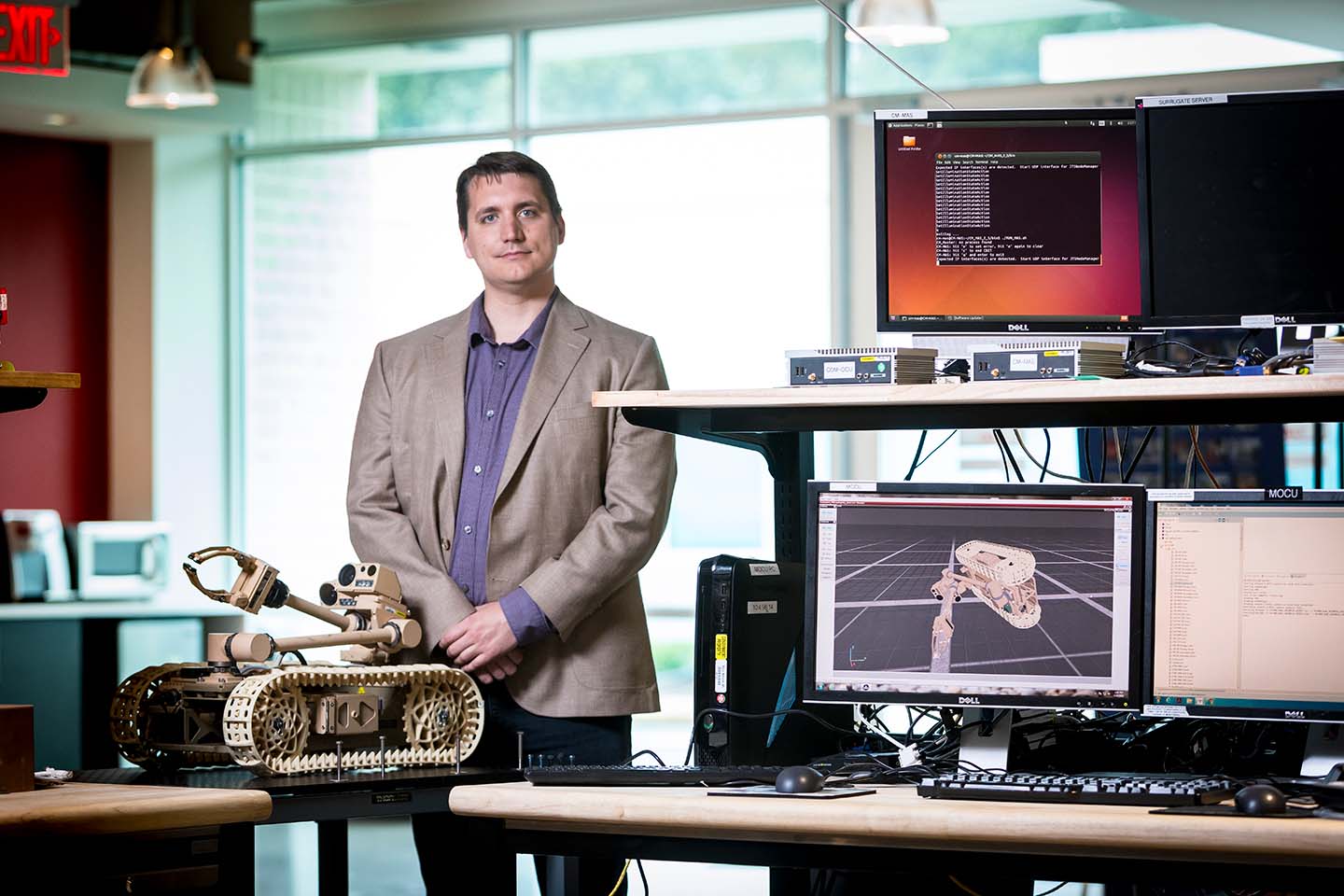Press Release
APL Teams with the Army to Develop Software for Self-Righting Autonomous Robots
Engineers at the Johns Hopkins University Applied Physics Laboratory (APL) in Laurel, Maryland, and the U.S. Army Research Laboratory have developed software that enables autonomous bomb-defusing robots to turn themselves back over, right side up, if they ever get flipped the wrong way.
This capability is critical to keeping soldiers out of harm’s way, noted Galen Mullins, lead author of “An Adaptive Sampling Approach for Evaluating Robot Self-Righting Capabilities,” published in IEEE Robotics and Automation Letters. “A robot that is not capable of self-righting is going to be severely limited in its ability to perform missions autonomously,” said Mullins, a mechanical engineer whose research focuses on machine learning and simulation techniques for increasing autonomy.
That’s why the ability to self-right is a key requirement of the Advanced Explosive Ordnance Disposal Robotic System, or AEODRS, a new family of explosive ordnance disposal robotic systems featuring a modular open systems architecture. The program is funded by the Navy and includes a team composed of APL, Northrop Grumman, OpenJAUS and GuardBot.
Chad Kessens, a robot manipulation researcher with the Army Research Laboratory, developed software that allows robots to analyze the situation they’re in and find solutions to get them back on their feet. First, he set about understanding how a robot’s morphology — its arrangement of joints, mass distribution and link lengths — affects its ability to recover from any possible overturned state.
“We then developed a metric for evaluating a robot’s ability to right, and we applied that to a simple notional robot design to see how varying parameters, such as arm length and mass, affected its ability to right,” he explained. “For example, if the arm is too short, it may not be able to flip itself back over because it has insufficient reach to push against the ground. However, if the arm is heavy enough, it could tip itself forward by reaching out. On the other hand, if the arm is too heavy, it may not stay on its feet.”
Kessens used that software to determine what percentage of a robot states (joint configuration and orientation) were capable of self-righting given various ground slopes; he then introduced dynamic (fast) motions and showed how that expanded the possibilities for righting.
He developed a simulation-based method for validating a robot’s self-righting capabilities by finding states where the robot tips over and then simulating how it rolled. However, he had no way of knowing which starting states to simulate beforehand and so exhaustively sampled them using a grid-based search. As the number of the robot’s joints increased, this search required exponentially more samples to find the transitions where the robot tipped over.
It also limited the search to tipping in a two-dimensional plane.
Kessens teamed up with Mullins, who — as part of APL’s Range Adversarial Planning Team (RAPT) — had been using advanced optimization techniques to explore the highly complex state space in which autonomous systems operate. They were also developing tools for test ranges to identify the most relevant tests for maritime, airborne and ground-based autonomous systems.
The adaptive algorithms developed as a part of RAPT enabled Kessens’ software to be applied to more complex robots in three dimensions. So, while the original results handled end-over-end tipping, the enhanced software also included side-to-side tipping.
“The real contribution of my algorithm is the reduction in the number of samples required to generate the self-righting plan,” Mullins explained. “It’s an evolutionary improvement, showing that my adaptive sampling algorithms can enhance the technology Chad’s team pioneered, allowing them to be applied to more complex systems that were previously out of reach.”
APL and the Naval Surface Warfare Center Indian Head EOD Technology Division are fine-tuning the performance of the first increment of AEODRS — a lightweight back-packable platform — and it is expected to move into production later this year.
This new sampling technique reduced the number of simulations required by more than 90% when applied to a model of ARL’s test-platform. The team then applied this technology to the AEODRS Increment 1 robot, demonstrating it could work in three dimensions with a high-fidelity robot model and a greater number of joints.
“While we knew that the AEODRS robot could self-right using preprogrammed scripts, we now had a validation that it could self-right from any starting position.” said Mullins.
